Flood Safety
Flood Safety Outdoors
Do not walk through flowing water. Drowning is the number-one cause of flood deaths. Currents can be deceptive; six inches of moving water can knock you off your feet. Use a pole or stick to ensure that the ground is still there before you go through an area under water.
Stay away from power lines and electrical wires. The number two flood killer after drowning is electrocution. Electrical current can travel through water. Report downed power lines to Commonwealth Edison at 1-800-334-7661 (1-800-Edison-1). Call 911 if people are in danger.
Do not drive through a flooded area. More people drown in their cars than anywhere else. Don’t drive around road barriers; the road or bridge may be washed out. A car can float in as little as two feet of water.
 |  |
Flood Safety in Cars
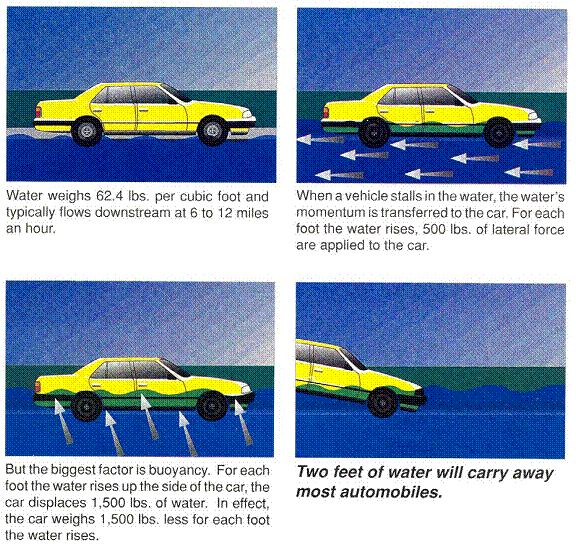
Flood Safety Indoors
- Turn off your electricity if your building is flooded. See the instructions. If you don’t feel safe doing this, call an electrician.
- Some appliances, such as television sets, can shock you even after they have been unplugged. Don’t use appliances or motors that have gotten wet unless they have been taken apart, cleaned, dried and inspected by a professional.
- Watch for animals. Small animals like rats and snakes that have been flooded out of their homes may seek shelter in yours. Use a pole or stick to poke and turn items over and scare away small animals.
- Look before you step. After a flood, the ground and floors are covered with debris including broken bottles and nails. Floors and stairs that have been covered with mud can be very slippery.
- Be alert for gas leaks. See the instructions on turning off your gas.
- Use a flashlight to inspect for damage. Don’t smoke or use candles, lanterns, or open flames unless you know the gas has been turned off and the area has been thoroughly aired out. If you have questions on gas, call 1-888-642-6748 (1-888-NICOR4U).
- Carbon monoxide exhaust kills. Use a generator or other gasoline-powered machine outdoors. The same goes for camping stoves. Fumes from charcoal are especially deadly — cook with charcoal outdoors.
- Clean everything that got wet. Flood waters have picked up sewage and chemicals from roads, farms, factories, and storage buildings. Spoiled food and flooded cosmetics and medicines are health hazards. When in doubt, throw them out.
Flood Safety − Turning Off the Electricity
The most important utility to turn off is electricity. You have a fuse box or a breaker box in the house. The breaker box is more common in newer buildings or if you have had some electrical work done in the last 10 – 20 years. The illustrations below shows how to turn off the power.
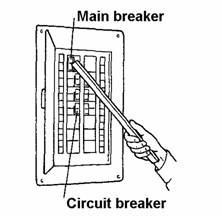 To turn off the electricity at a breaker box: 1. Stand on a dry spot. | 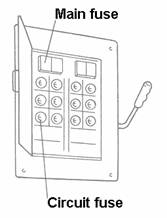 To turn off the electricity at a fuse box: 1. Stand on a dry spot. |
Flood Safety − Gas Leaks
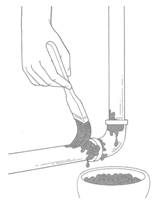 | If you find any pipes that smell like gas, brush soapy water on each pipe connection. The pressure in the pipes will make bubbles appear where there is a leak. |
Check for leaky fuel pipes by smelling for gas. A chemical that has a disagreeable, distinctive odor is added to natural gas and propane to tell you if there is a leak. If you have any doubts, have a professional check for you. Do not use open flames.
Make sure the valve that leads to each appliance is closed. If you find any pipes that moved or any area that smells like gas, brush soapy water on each pipe connection (as illustrated). The pressure in the pipes will make bubbles appear where there is a leak.
If you find a leak, turn off the gas. Unscrew the pipe connection, clean the joint, and apply pipe joint compound or pipe tape (available at hardware stores) on the threads. Screw the pieces back together tightly. Turn on the gas and check the connection again with soapy water. If you have a leak, or you are not sure your system is safe, turn off the gas and call 1-888-642-6748 (1-888-NICOR4U).
Flood Safety − Turning off the Gas
Floodwaters may knock out pilot lights and silt may get into burners. To prevent a fire and safety hazard, you should turn off the gas before you leave. There is a valve next to the gas meter. If the valve handle is parallel to the pipe, the gas is on. You may need a pair of pliers or a wrench to turn the valve. Turn it 90 degrees (a quarter turn) so the handle is perpendicular to the pipe to shut the gas off.
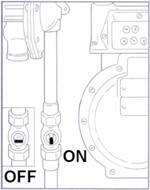 | To turn off the gas: 1. There is a valve next to the gas meter. If it is parallel to the pipe, the gas is on. |
Most gas meter valves have a hole in the handle that lines up with a hole in the valve body when the gas is shut off. This hole is used by the gas company to lock or seal the valve closed when the building is vacant. When the holes are lined up, you know that the gas supply has been shut off. If you have any doubts, play it safe and call 1-888-642-6748 (1-888-NICOR4U).
Flood Safety − Turning off the Water
Since your water faucets are usually turned off, you shouldn’t have to worry about turning all the water to the house off before or during a flood. However, if your washing machine is in the basement, or if the floodwaters around your house could be several feet deep, the floodwaters could get into the water lines through the appliances.
If you have the time, turn off the water to the house. There should be a valve near the water meter, similar to a faucet knob. Turn it all the way clockwise.

